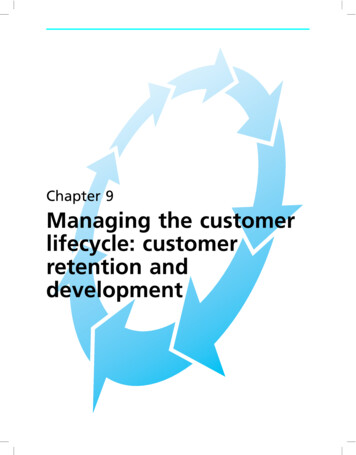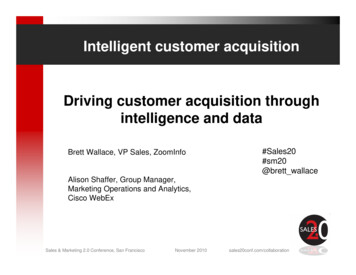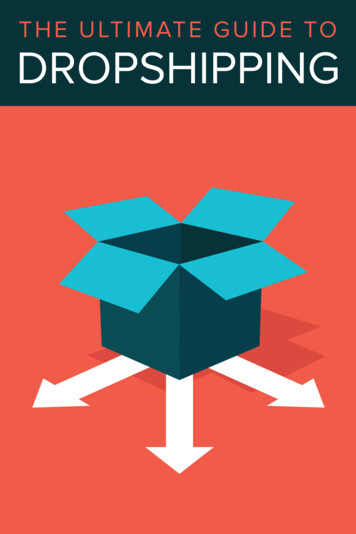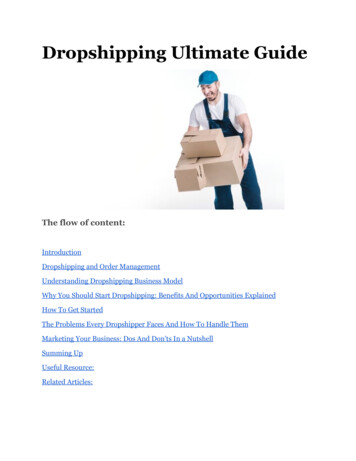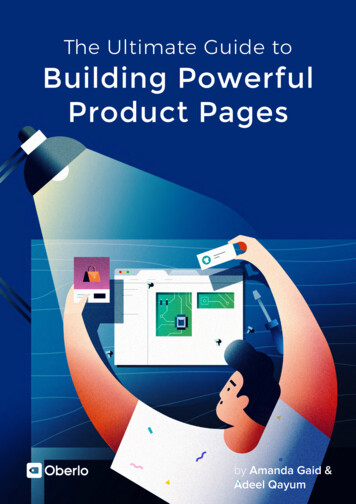
Transcription
The Ultimate Guideto Customer Training
CONTENTS12478Creating Revolutionary Technology Is One Thing.Ensuring Your Customers Can Use It Is Another.Customer Training Is Critical to theLong-Term Profitability of Your Tech CompanyThree Elements to a SuccessfulCustomer Training ProgramGetting StartedAbout Cornerstone OnDemand
Creating Revolutionary Technology IsOne Thing. Ensuring Your CustomersCan Use It Is Another.Not surprisingly, the economic outlook for the technology industry is positive.Tech companies have tremendous new opportunities in multiple areas, fromdeveloping new robotic automation processes (RPAs) to broadening thecapabilities of artificial intelligence. According to Deloitte’s 2017 TechnologyIndustry Outlook, tech enterprises are poised for growth in machine learning,cybersecurity, and the development of even more service-based offerings.1For tech companies, rapidly creating and updating products and servicesfor customers isn’t the biggest challenge. Getting customers to just asrapidly adopt and use those services with confidence is.Yet while tech companies will continue to operate on the leading edge ofbusiness, maturation is bringing new difficulties. Other industries may stillstruggle with nurturing innovation and creative thinking, something the techindustry has already mastered. For tech companies, rapidly creating andupdating products and services for customers isn’t the biggest challenge.Getting customers to just as rapidly adopt and use those services withconfidence is.Early adopters—those willing to wait in around-the-block lines for themost updated smartphone or download updates the moment they hitthe app store—make up only 28% of Americans.2For companies accustomed to the rapid pace of cyber-development, theslower pace of customer adoption is a big barrier to growth. After all, howprofitable is that new feature or update if no one is ready to use it? Earlyadopters—those willing to wait in around-the-block lines for the mostupdated smartphone or download updates the moment they hit the appstore—make up only 28% of Americans.3 (In contrast, 37% of Americanadults consider themselves early adopters of food products.)1
For tech companies needing to capture early market share or keep existingcustomers intrigued when a new upstart start-up promises a cheaper, hipperservice, a low percentage of early adopters can lead to an early marketplacedeath. Even the 45% of Americans with a “medium” preference for newtechnology are a concern in an industry where “the early bird gets the worm”is less a proverb than a real-life manifesto.So how are vanguard tech companies ensuring all customers can keepup with changing technology?By offering extended training that not only increases adoption and usagebut also turns customers into fierce, loyal brand advocates.Customer Training Is Criticalto the Long-Term Profitabilityof Your Tech CompanyIn the early days of the technology industry, providing customers withtraining on software and hardware was a given. Ensuring customers weresupported was key to building the still nascent industry. Yet as time wenton, training became more of an afterthought, something that was necessarybut often seen as too resource intensive. Free, one-on-one, personalizedphone service morphed into vague online forums where customers had toexecute time-consuming web searches, all to find answers that were “closeenough.” And FAQS, while still a crucial element of customer service andtraining, became the default (less-than-helpful) help option.But in an industry where it’s easier than ever to offer a competing servicein mere months, customer service and customer training are becomingthe only true differentiators.2
But in an industry where it’s easier than ever to offer a competing servicein mere months, customer service and customer training are becoming theonly true differentiators. And with software primarily a subscription-basedservice, keeping a customer engaged and invested, year to year if not monthto month, is crucial to retaining that customer’s business.Retention—in an era of fierce, ever-faster, ever-cheaper competition—is thegame changer for technology companies focused on profit and longevity Increasing customer retention by a mere 5% translates to a 25% to 95%increase in customer profitability over time.Retention—in an era of fierce, ever-faster, ever-cheaper competition—is thegame changer for technology companies focused on profit and longevity.Keeping existing customers happy is far less expensive—by five times—thanwooing a new customer. Long-term customers also use help resources less,as they become more adept at using a technology offering, thereby savingtech companies money. Finally, increasing customer retention by a mere 5%translates to a 25% to 95% increase in customer profitability over time.4
According to 2017 research by the Brandon Hall Group, training offered tocustomers can have a “huge impact on customer retention and positivenet promoter scores, and is also linked to sales outcomes.” The surveyshowed that companies that provided extended enterprise learning reportedmeasurable business benefits:69 65 65%increased awarenessof products/services%improved customerrelations%maximized customerretentionOffering training doesn’t just help tech companies retain and engagecustomers. Training can also help companies save money by reducingthe use of help desks. The Brandon Hall Group survey also discoveredthat companies that offered customer training reported a 35% reductionin client support interactions.5Three Elements to a SuccessfulCustomer Training ProgramFor many industries, providing continuous training is critical to attracting newusers and engaging and retaining existing ones. For those in the technologyindustry, training is also powerful differentiator, one that is quickly becomingnon-negotiable for companies that want to not just survive but thrive amidincreasing competition.Yet customers’ training needs are more complex than a downloadable PDFor an online FAQ. How then can tech companies create the right kind oftraining programs for customers? By integrating the three key elementsthat all successful customer training programs have in common: Learning is continuous and structured to build skills and capacity over time. Learning is just-in-time. Learning is aligned with customer goals.4
1LEARNING IS CONTINUOUS AND STRUCTURED TO BUILDSKILLS AND CAPACITY OVER TIME.Successful customer training starts with basic skills and builds on thoseskills over time. In fact, smart technology companies ensure training isongoing for both employees and external stakeholders, such as customers.As customers gain experience and are ready for new knowledge, trainingresponds in kind.Smart technology companies ensure training is ongoing for bothemployees and external stakeholders, such as customers. Ascustomers gain experience and are ready for new knowledge,training responds in kind.For tech companies, this requires planning with the end in mind, namelyhow to best facilitate a logical skills progression. Rather than overwhelmcustomers with an hour-long course, tech companies can “drip” learning byproviding bite-sized, relevant lessons over time. Delivering training over timebenefits retention and ensures customers continue to engage.2LEARNING THAT IS JUST-IN-TIMEIn addition to more formal courses, customers will still need answers toquestions as they use the new software or other offering. Just-in-timetraining delivers knowledge and solutions as customers need it, whenit’s most relevant. This not only reduces frustration and thereby sustainsengagement, but studies show that knowledge that is gained in the momentof need is retained longer.Just-in-time training delivers knowledge and solutions as customers needit, when it’s most relevant.5
3LEARNING THAT IS ALIGNED WITH CUSTOMER GOALS.Your organization’s goal is to keep customers using your technology overtime. But customers have goals for your technology, as well. Tappinginto these aspirations and creating training that enables customers toachieve milestones—such as ongoing certifications—can be a powerfulengagement tool.Thirty-percent of respondents in the 2017 Extended Enterprise Learningstudy stated they were able to cover more than 50% of their annual learningmanagement system (LMS) costs via extended learning revenues.6Training that is aligned with customer goals can also have a more directmonetary benefit. Motivated customers are usually willing to pay fordevelopment that helps them achieve both professional and personalaspirations. In fact, research by the Brandon Hall Group showed thatorganizations recoup some costs of an extended enterprise technologyplatform by charging for certain content. Thirty-percent of respondentsin the 2017 Extended Enterprise Learning study stated they were able tocover more than 50% of their annual learning management system (LMS)costs via extended learning revenues.
Getting StartedKnowing extended learning opportunities are beneficial to customers is onething. Taking action to create a successful customer training program isanother. The first step? Use this questionnaire to assess the effectivenessof your current customer training program. Learning that is tailored to the changing needs of thecustomer requires planning ahead. What goals have you established for customers? For example, whatshould beginner users be able to accomplish? Experienced users? How are you tracking and measuring the achievement of these goals? Is current training available as it’s needed, e.g., just-in-time and withinthe technology itself? Or do customers have to interrupt what they’redoing to hunt for a solution? Designing, managing, and updating curriculum takestime and resources. How easily can you create courses—and course paths—to bestaccommodate customer needs while still enabling the fastdistribution of training? Does current training engage customers with new ways of learning, suchas gamification, short videos, user collaboration opportunities, etc.? Creating and managing a successful continuous learningprogram for customers requires not just planning buta platform. What technology are you using now to deliver on-demand, just-in-time,and collaborative learning opportunities to customers? Is this technology seamless and integrated for delivery? Can it providereporting and analytics, such as customer history, purchases, lessonscompleted, etc., to leverage for sales and marketing outreach later? Within your existing learning program, is content easy to update? Is your existing learning management system capable of deliveringbite-sized lessons in the moment of need? For example, can a customerlearn while doing? Is learning accessible on mobile devices, as well?7
About Cornerstone OnDemandCornerstone OnDemand (NASDAQ: CSOD) is pioneering solutions to helporganizations realize the potential of the modern workforce. As a globalleader in cloud-based learning and human capital management software,Cornerstone is designed to enable a lifetime of learning and developmentthat is fundamental to the growth of employees and organizations. Fromrecruitment, onboarding, training and collaboration, to performancemanagement, compensation, succession planning, people administrationand analytics, Cornerstone is there at every phase of the employeelifecycle. The company’s solutions are used by nearly 3,000 clientsworldwide, spanning more than 31 million users across 191 countriesand 43 t-customers Brandon Hall Group/Cornerstone OnDemand. “Extended Enterprise Learning: A Profit Driver for Leading Organizations.”June 2017. Page 5.Cornerstone OnDemand is the global talent management software provider that is pioneeringsolutions to help organizations realize the potential of a modern workforce. csod.com 2017 Cornerstone OnDemand moreinfo@csod.com 888-365-CSODStay connected:8
Cornerstone OnDemand (NASDAQ: CSOD) is pioneering solutions to help organizations realize the potential of the modern workforce. As a global leader in cloud-based learning and human capital management software, Cornerstone is designed to enable a lifetime of learning and development that is
